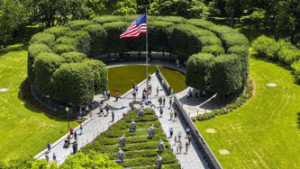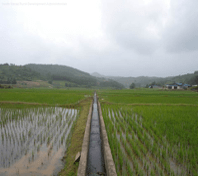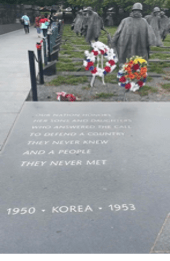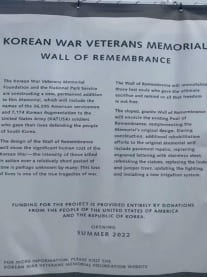Plan your next visit to Washington, D.C. to see this historical tribute for the soldiers that fought in the Korean War (1950-1953).

By Evelyn R.
While Washington, D.C. is home to numerous monuments dedicated to honoring and remembering the soldiers that sacrificed their lives for the liberty of America, the Korean War Veterans Memorial attracts millions of visitors every single year. The memorial was authorized for construction in West Potomac Park in 1985 and was dedicated by President Bill Clinton in 1995. The site is located just southeast of the Lincoln Memorial and sits across from the Vietnam Veterans Memorial. The monument has been under recent construction but remains open to the public as new additions are made.
The Korean War lasted three years from 1950 to 1953. After the second world war, Korea was freed from Japanese control before splitting in half at the 38th Parallel in 1948. North Korea was occupied by Soviet Union forces and controlled by communist Kim Il-Sung, while South Korea was occupied by American forces and under the control of capitalist Syngnam Rhee. When both military forces left Korea between 1948-1949, North Korea invaded and captured the capital city of South Korea on June 25th, 1950.
In an attempt to contain the spread of communism, the United Nations sent an international force – mostly American – of 16 nations to South Korea. On September 15th of 1950, U.S. marines launched an amphibious attack and were able to recapture the south. While President Truman initially wanted to simply contain communism, the U.S. went on the offensive in North Korea and captured its capital in October of 1950. This caused China to retaliate and send 250,000 troops to help the north, forcing U.S. troops to push back. While U.N. reinforcements were able to stabilize the 38th Parallel in June of 1951, American pilots were still fighting Soviets using Chinese jet fighters.
 When President Eisenhower took office, he was able to negotiate an armistice in 1953, signaling the end of the war. While North & South Korea took the most casualties, over 35,000 American troops diedwhile fighting to stop the spread of communism. These brave soldiers were commemorated for their service through the construction of the Korean War Veterans Memorial.
When President Eisenhower took office, he was able to negotiate an armistice in 1953, signaling the end of the war. While North & South Korea took the most casualties, over 35,000 American troops diedwhile fighting to stop the spread of communism. These brave soldiers were commemorated for their service through the construction of the Korean War Veterans Memorial.
Dedicated to memorializing the tens of thousands of veterans who died in South Korea, the monument is made up of several components. The first is the 19 stainless steel figures that represent members from each branch of the U.S. Armed Forces, located at the center of the memorial. The statues are about 7 feet tall, scattered between juniper bushes that represent rice paddies in Korea. This is meant to depict the rough Korean terrain in which soldiers bravely fought in.


What makes these figures interesting is that they are depicted as moving toward a flag at the apex of the triangle called the Field of Service. The soldiers are watchful in all directions with ponchos and weapons as they carefully make their way across the field. At the top of the triangle, a granite slab is inscribed with the words “Our nation honors her sons and daughters who answered the call to defend a country they never knew and a people they never met.”
 Adjacent to the steel soldiers, the monument features a 50-meter long (164 feet) granite mural wall with the faces of 2,400 service people inscribed into it – also known as the Mural Wall. The wall is extremely reflective and creates a mirror effect with the statues, giving the illusion of 38 soldiers in reference to the 38th parallel – the dividing line of North and South Korea during the war.
Adjacent to the steel soldiers, the monument features a 50-meter long (164 feet) granite mural wall with the faces of 2,400 service people inscribed into it – also known as the Mural Wall. The wall is extremely reflective and creates a mirror effect with the statues, giving the illusion of 38 soldiers in reference to the 38th parallel – the dividing line of North and South Korea during the war.
The apex of the triangular plot of land that the statues sit upon leads to the Pool of Remembrance, which is currently inaccessible to visitors due to current construction. The pool is encircled by trees and has inscriptions that list how many soldiers were wounded, imprisoned in Korea, or killed. “FREEDOM IS NOT FREE” is also written on the end of the mural wall leading to the pool area, next to the United Nations wall that lists all 22 members of the U.N. who contributed to the war effort .
The final part of the monument is the Wall of Remembrance, which is the newest addition to the memorial. Its construction began in March of 2021 and will feature the names of the 36,595 American service members and 7,174 members of the Korean Augmentation to the U.S. Army who gave their lives in the war. The granite wall is planned to encircle the Pool of Remembrance and is set to be completed by this summer.
Each component of the Korean War Veterans Memorial is deeply profound in its representation of the war and how it chooses to remember the 5.8 million Americans who served. Recognizing each service member by name helps give us a better perspective of just how many lives were lost in this fight. Further, strategically depicting the battlefield using bushes and rain ponchos to portray the topography really allows the audience to imagine what it felt like to actually be there. Finally, seeing the actual faces of soldiers on the Mural Wall that stretches for 164 feet gives visitors a visual that they will never forget.
 While other monuments, like the World War II Memorial, are more symbolic in honoring the commitment and sacrifice of Americans, the Korean War Veterans Memorial pays tribute directly to the soldiers who fought and died. This distinguishes it from other memorials because of how transpicuous the design is. Additionally, efforts to continue enhancing the original compositions to honor the veterans challenges the belief that the Korean War was the “Forgotten War.” Despite its untraditional ending with a ceasefire agreement, this conflict still took soldiers away from their families, and their sacrifice for the world will never be forgotten.
While other monuments, like the World War II Memorial, are more symbolic in honoring the commitment and sacrifice of Americans, the Korean War Veterans Memorial pays tribute directly to the soldiers who fought and died. This distinguishes it from other memorials because of how transpicuous the design is. Additionally, efforts to continue enhancing the original compositions to honor the veterans challenges the belief that the Korean War was the “Forgotten War.” Despite its untraditional ending with a ceasefire agreement, this conflict still took soldiers away from their families, and their sacrifice for the world will never be forgotten.
If you are or will be in Washington, D.C. you should add this memorial to your agenda so you can see it for yourself!
Additionally, here are links to further resources you can use to familiarize yourself with the memorial!
- The Korean War (1950–53) is a video that briefly explains the history behind the Korean War and explains what military actions were taken throughout the three-year conflict.
- Visiting the Korean War Veterans Memorial in Washington, D.C. offers a description of each component of the monument and also provides directions..
- Korean War Veterans Memorial Wall of Remembrance gives a project glance of the newest addition to the memorial that should be completed by Summer 2022.
- Number of recreational visitors to the Korean War Veterans Memorial in the United States from 2008 to 2021 provides statistics on how many people have visited the memorial each year.
- Korean War Veterans Memorial describes the monument in specific detail and also offers brief history on the war.
- Korean War explains the start and causes of the Korean War and also discusses its fatalities.
- Korean War Memorial offers more pictures of the memorial for those unable to see it in person.
